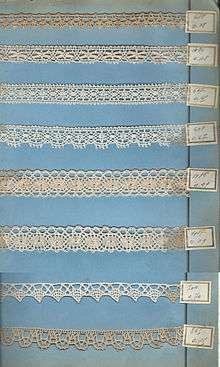Barmen lace machine

The Barmen lace machine makes perfect copies of Torchon and the simpler hand-made bobbin lace. Its bobbins imitate the movements of the bobbins of the hand-made lace maker.[1]
History
The Barmen machine was developed in the 1890s in Germany from a braiding machine. The Barmen laces were derived from solid braids later pieced with openwork.[2]
Design of machine
[[File:Barmen torchon machine.png|thumb|right|Barmen lace machine, showing its workings
A. Spindle set in top plate B. Yarn threaded upto mandrill C. Beater dome C1. Beater knives D. Mandrill (varible settings) E. Finished Lace F. Jacquard G. Pulley for drive belt H. Hand wheel K. Beater cams L. Take-up rolls M. Handle to engage drive belt
]]
The Barmen machine has its spindles arranged in a circle, each one carrying a large bobbin of thread. These can pass each other, so their threads twine together in a complex way. The threads run towards the centre, where the finished lace appears, rising upwards. The machine can only make one width at a time, and has a maximum width of about 120 threads. The lace is made as a cylinder. When finished, threads are removed to allow the flat strip to appear.[2]
Uses
Barmen machines can make laces, trimmings, elasticated and rigid braids, cords and ric-racs. Barmen lace is still produced in Britain by Malmic Lace Limited, in Nottingham.[3]
References
- ↑ Jeremy Farrell (2007). "Identifying Handmade and Machine Lace" (PDF). DATS (Dress and Textile Specialists) in partnership with the V&A.
- 1 2 Earnshaw, Pat (1986). Lace Machines and Machine Laces. ISBN 0 7134 4684 6.
- ↑ "Malmic Lace Limited". Malmic Lace Limited.
